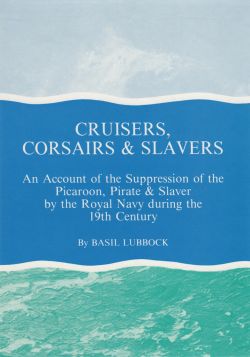
Cruisers, Corsairs & Slavers
- Price:
- £35.00
Item attributes
- ISBN:
- 978-0-85174-593-0
- Published date:
- First published 1993
Item details
"Extract from the Preface"
I have compiled this chronology of Naval actions against the picaroon, pirate and slaver of the nineteenth century for three reasons.
In the first place I wish to show the modern generation of sailors how their ancestors carried on their 'lawful occasions'.
In these days of trust in the machine the human element is in some danger of losing its power of initiative, and that spirit of dash and enterprise, which should compose the ground tier of every naval officer.
Admiral of the Fleet, Sir George Keyes tells us in his memoirs that there were two schools of thought in the Royal Navy during the Great War · the "material" school and what I will call the "do and dare" school. By the end of the war, officers who had followed out the tenets of the latter school were to be found at the head of things, in every fleet, on every station, through every clime they were the leaders of the King's Navee!
But in peace time the lessons of war tend to be forgotten and specialists in the complicated machinery of the modern war engine gradually slip into all the best jobs, whilst the all round sailor, who may possess the gift of command and that priceless Nelson touch,the spice of nerve and daring, which must be met at the bottom of every successful action, is liable to miss his chance through lack of opportunity.
At the same time, many a clever and promising officer is led away from the executive into the soul-deadening den of the scientific expert, where he loses his individual personality in familiarizing himself with the mathematical symbols of astronomy and physics, the combinations and coefficients of machinery, the abstractions and permutations of the master gunner, the chemical formulae of the gas man and the delicate explosive forces of the mine and torpedo man.
Yet there is nothing in mechanics that the most moderate brain cannot grasp, and only practise is needed to make one perfect in the most complicated engine of destruction, whereas the command of men and of ships needs every virtue of the spirit, every effort of the mind and all the strength of the body, and when these attributes are present, on top of them, full years of rich experience.
In the following pages the reader will find countless examples of superb leadership and, I hope, will gain a very good idea of why the British Navy became such a power in the world.
My second reason for this book is my desire to trace the development of the ship of war, especially in the smaller, more hard-worked, if less spectacular, classes, from the time of Nelson down to the appearance of the first armour-clad battleship.
This takes in a period when ship speed was becoming of the first consideration, when the paddle and the screw were slowly ousting canvas, wire and chain conquering hemp and manila and iron plates and rivets being seriously suggested as a substitute for the frames, beams and planking of oak, teak and pine which for a thousand years had been the material; composing Britannia's Wooden Walls.
It was also a time of iron discipline and that smartness in sail drill, which produced the most athletic, not to say acrobatic, sailor the world has ever known.
Lastly no attempt has ever been made to drag the gallant record of the Royal Navy, in its hard task of suppressing the pirate and the slaver, from the musty shelves of the Admiralty and the Public Record Office.
This has badly needed doing and I only wish someone with greater skill and knowledge than myself could have been induced to attempt it.
Related Titles: The Basil Lubbock Collection

